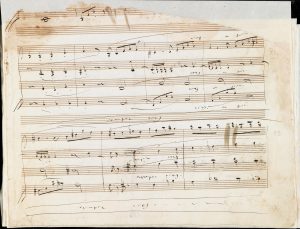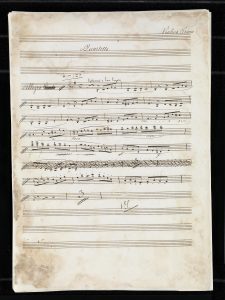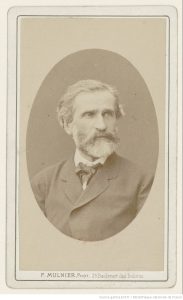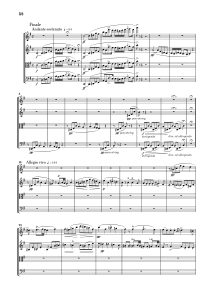Our recently published new edition of Giuseppe Verdi’s String Quartet in E minor (study edition HN 7588 as well as Urtext parts edition HN 1588) offers a bit of a sensation. The editor, Verdi scholar Anselm Gerhard, Bern emeritus professor of musicology, discovered not long ago in the composer’s estate a previously unknown first version (included as an appendix in HN 7588 and available as a parts edition in the Henle Library App). We’ve asked Professor Gerhard for an interview about the story of that discovery and its consequences in assessing this quartet, Verdi’s sole major chamber-music work.
Peter Jost (PJ): Verdi’s musical legacy has only been accessible to research since autumn 2019. How can we explain this extremely late date, well over a century after the composer’s death?
Anselm Gerhard (AG): As was customary in the 19th century, the definitive full-score manuscripts of Verdi’s Italian operas went to the Ricordi publishing house in Milan (now in the National Library there), those of the French operas to the Opéra in Paris. The working manuscripts, conversely, were the composer’s property, remaining after his death in his Sant’Agata villa.
During the second half of the 20th century, his adopted daughter’s great-grandchildren permitted selected researchers access to some of these holdings, though the next generation of great-great-grandchildren vetoed all requests. This eventually became too much for the government regulators of private archives. Thus, in 2017 and 2019 these manuscripts were expropriated in two steps (first de facto, later also de jure). As of 2019 the music manuscripts became freely accessible from the Parma State Archives as digital copies, and I was also able to study the originals for the first time in the autumn of 2022.
PJ: You were probably looking for the opera music manuscripts in the estate? Or, was there any indication of extant string-quartet material?
AG: Although materials for all operas composed since 1849 can indeed be found, these are evidently not complete. Thus, inexplicably, there’s not a single note of the new Macbeth version composed in Sant’Agata in 1864/65, and completely missing in the Otello material are almost the entire first two acts. In that sense, it was a great surprise to find such extensive string-quartet material.
PJ: The real sensation, though, was the discovery of materials significantly differing from the previously known printed version. What was that all about?
AG: Included in the Sant’Agata manuscripts is a complete set of professionally copied parts that Verdi himself corrected, together also with his autograph score matching this set of parts, though not quite in full. Only a happenstance must have saved it from destruction, for all the leaves are torn in the middle, as most likely destined for the wastepaper basket.

Only the lower half of the autograph score’s first page of the first version is extant after being torn in two (Parma, Archivio di stato).
PJ: The first string-quartet drafts can be dated at the latest to autumn 1868. As such, the quartet composition cannot have been undertaken as spontaneously as Verdi himself portrays it – as quasi “filling in the breaks” during enforced leisure hours in Naples at the start of 1873?
AG: There is probably a kernel of truth in Verdi’s obviously contrived story about the quartet’s spontaneous composition during an unexpected, compulsory interruption in Naples (rehearsals had repeatedly to be postponed there in the Aida production since two singers had fallen ill). For even though he had begun drafting this work more than four years earlier, the first version’s performance material was obviously produced in the greatest haste, with the copyist of the totally extant set of parts having made numerous corrections through paste-overs. And in these parts Verdi himself added the slow introduction to the final movement. He therefore very plausibly used the time during the first three months of 1873 to establish then and there a first performable version of his string quartet that had been underway for years.

To be seen on the first page of the copyist’s Violin I part is that at the last minute Verdi extended the transition passage following the main theme (Parma, Archivio di stato).
PJ: The quartet’s first performance on 1 April 1873 is confirmed within a private setting in a Naples hotel – how certain is the supposition that the first version was heard then?
AG: As a philologist, I ought to be cautious: The sources do not provide any “watertight” evidence that the set of parts and the fragmentarily extant autograph score document the version heard in 1873. Added rehearsal letters indicate, however, that the parts set was obviously made for a performance. As the quartet was performed only once before the final version’s premiere in Paris in 1876, Naples in 1873 is thus the only conceivable occasion for producing these manuscripts.
PJ: Could you very briefly described the differences between the first version and the well-known final version?
AG: It was the fourth movement that Verdi most fundamentally altered: Using almost the same motivic material, a “palatable”, melody-saturated fugue to be played legato at a moderate tempo has now become an unfettered “scherzo”. With a tempo at the limit of playability, performed staccato almost throughout, the movement seems to have had any “espressivo” stripped away from it. Deleting the slow introduction that was added at the last minute in 1873, points in the same direction. Quite the same is true of the first movement: during the revision, Verdi added passages seemingly extravagant in sound, whilst transition sections demonstrate a considerable increase in polyphonic ambition. The third movement, on the other hand, is identical in both versions – aside from the metronome indication –, whilst the second is merely extended by a few contrasting passages.
PJ: As part of a lecture recital, the Vogler Quartet presented this first version, based on the Henle Edition, in Leipzig on 27 March 2023, that is, almost exactly 150 years after the conjectured performance in 1873. What was your impression?
AG: The first version is less brilliant than the well-known version, less contrived, perhaps less polished, but in many ways more spontaneous. So, a real alternative that is in any event worth study and performance.
PJ: Given the great success of this string quartet that preoccupied Verdi for more than seven years, the question arises as to why he did not make any further attempts in this genre?
AG: Well, Verdi’s music manuscripts also include drafts for very short string-quartet movements in F major and G major from the years around 1870, possibly the germ cells of other planned quartets. But these he did not elaborate. I surmise that with the publication of the Quartet in E minor in the autumn of 1876, the purpose of his excursion into string chamber music was fulfilled. He had wanted to show himself and the world that he also had at his command typically “German” qualities: the writing technique of distributing melodic fragments over various voices (“durchbrochene Arbeit”), polyphonic craftmanship, instrumental music without a dramatic function. For the differences between the two versions all point in the same direction: as skilful and as dense as possible in order to shine in the (sometimes only seemingly) contrapuntal writing.
PJ: Dear Professor Gerhard, warm thanks for this interview.
Those who would like to know more may refer to Anselm Gerhard’s just published, detailed article Eine Komposition „ohne die geringste Bedeutung“. Verdis Mußestunden in Neapel und seine mindestens sieben Jahre währende Arbeit am Streichquartett in e-Moll, in: verdiperspektiven 5/2020 [2022], pp. 59–112.


